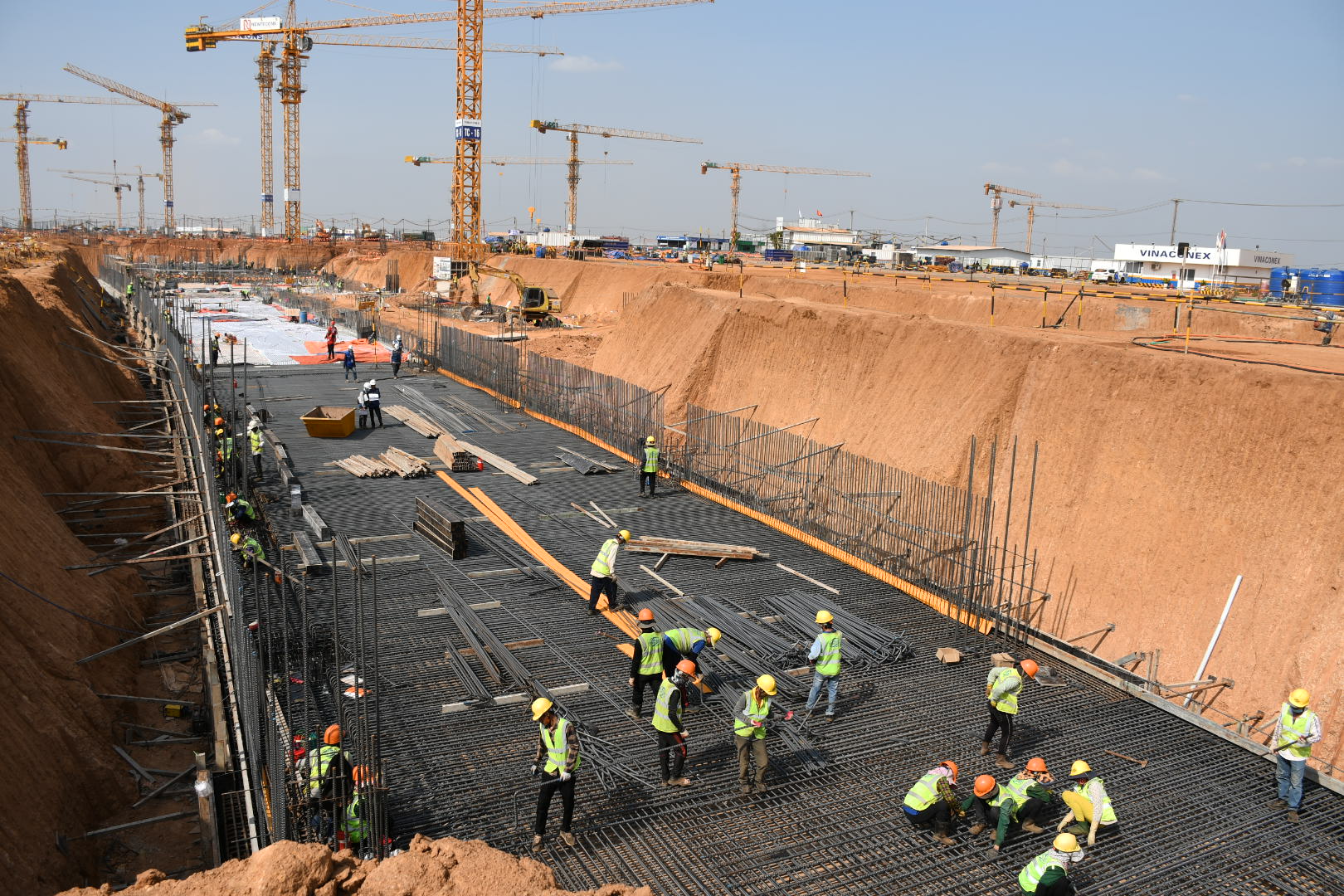The disbursed results of the public investment in 2023 create an important momentum for localities, ministries, and sectors to continue disbursing funds at a high rate in 2024 – the year of acceleration to complete the medium-term public investment plan for the period 2021 – 2025.
Strengthening the allocation of funds
Based on the estimated budget for 2024 approved by the National Assembly, the Prime Minister issued Decision 1603/2023 on the investment plan for state budget funds in 2024 with a total amount of VND 677.349 trillion, equivalent to 95% of the 2023 plan.
Although the total public investment capital in 2024 decreases slightly compared to 2023, in the context of many difficulties in the global economy and uncertain international situation, to achieve the minimum disbursement target of 95% of the allocated public investment funds, effective solutions are needed from all levels, sectors, localities, and investors.
Since the beginning of 2024, ministries, sectors, and localities have promptly allocated detailed public investment funds. For example, Thai Nguyen province has allocated 100% of the Prime Minister’s allocated capital for 2024, which is VND 5.612 trillion, and an additional VND 2.982 trillion from the local budget. This is an important basis and condition to promote the implementation of projects and enhance infrastructure to attract local socio-economic development investment.
Also at the beginning of the year, Hanoi city set a high public investment plan for 2024, which is 1.4 times higher than in 2023. Mr. Ha Minh Hai, Vice Chairman of the Hanoi People’s Committee, said that this year, the city has been allocated VND 81.033 trillion for public investment, including VND 9.451 trillion from the central budget and VND 71.582 trillion from the local budget. Hanoi has allocated and implemented the investment plan to ensure the progress of capital disbursement.
Mr. Le Anh Duong, Chairman of the Bac Giang People’s Committee, also stated that he has requested departments and sectors to vigorously disburse public investment funds to achieve 100% of the allocated plan for 2024. The province focuses on accelerating the process of land clearance, construction progress, and resolving difficulties related to mining permits and exploitation of natural resources for projects.
The determination of ministries, sectors, and localities can be seen through the disbursement of public investment funds in the first month of 2024. According to the report of the Ministry of Finance, by the end of January 2024, the national disbursement of public investment capital has reached over VND 16.934 trillion, reaching 2.58% of the Prime Minister’s assigned plan and higher than the same period last year.
Regarding key projects, the total allocated plan for public investment in 2024 by the Ministry of Transport and localities is over VND 127.593 trillion. Many important transportation infrastructure projects have been implemented during the Lunar New Year with the spirit of “overcome sunlight, win over rain,” and “three shifts and four operations” to meet and exceed the schedule.

Workers and engineers working during the Lunar New Year at the Long Thanh International Airport project. Photo by Nguyen Tuan.
Connected with performance appraisal of officials
In the context of the economy still facing many difficulties and challenges, public investment continues to play a role as a “seed capital” to stimulate overall investment, creating an important motivation to achieve the economic growth target of 6% – 6.5% this year.
According to Minister of Planning and Investment Nguyen Chi Dung, it is necessary to prioritize public investment for consistent governance. The minister emphasized that the same institutional framework and policies have led to different disbursement rates for different ministries, sectors, and localities due to the effective and resolute guidance of the leaders. Therefore, ministries, sectors, and localities need to elevate the sense of responsibility, set examples, and promote the role of leaders in guiding, supervising, and organizing the disbursement of public investment funds.
Minister Nguyen Chi Dung noted that in 2024, it is necessary to prepare, implement, and select projects that meet the conditions for capital allocation to enhance preparedness and feasibility. “The units directly implementing the public investment plan need to proactively review, provide timely and accurate information about difficulties and obstacles to facilitate policy-making and strong and rapid solutions to meet practical requirements,” suggested the leader of the Ministry of Planning and Investment.
Mr. Nguyen Van Thang, Minister of Transport, stated that in 2024, the entire sector will focus on accelerating disbursement and strive to achieve a minimum of 97% – 98% of the allocated capital plan. Specifically, the focus will be on the construction and implementation of ongoing projects, especially the North-South expressway projects of the 2017 – 2020 and 2021 – 2025 phases.
The leaders of the Ministry of Transport required departments and project management boards to coordinate with localities to promptly resolve difficulties and obstacles to implement the assigned highway projects and ensure that by 2025, there will be 3,000 km of expressways nationwide.
The Ministry of Finance also suggested that ministries, sectors, and localities continue to emphasize the responsibility of leaders in guiding, supervising, and urging the disbursement of public investment funds. They should publicly announce the results of implementation by units, link the disbursement results of each unit with the performance evaluation of officials, and review and criticize cases that do not fulfill the plan.
At the local level, Bac Giang province has strict disciplinary measures for investors, project management boards, organizations, and individuals who deliberately create difficulties, hinder, and slow down the progress of implementing and disbursing public investment funds. The Chairman of the provincial People’s Committee affirmed that they will promptly replace inefficient, sluggish, disruptive, and troublesome officials and civil servants and strictly handle negative behaviors and corruption in managing and implementing public investment.
New growth space with expressways
Minister Nguyen Chi Dung said that the public investment has been restructured towards concentrating resources on major projects and key transportation projects, especially expressways.
In 2023, the country put into operation 475 km of expressways, raising the total length of operational expressways to about 1,900 km. The expressway system has created new spaces and development corridors, promoting local socio-economic development, attracting investment, and enhancing infrastructure connectivity nationwide.
Separating land clearance into independent projects
Assoc. Prof. Hoang Van Cuong, Member of the National Assembly’s Finance – Budget Committee, analyzed that public investment creates employment and stimulates economic growth. Therefore, the Government needs to have more determined solutions to remove bottlenecks, especially in land clearance; proactively review to transfer capital early from the beginning of the year; and expedite project investment procedures.
Regarding the land clearance bottleneck, Mr. Nguyen Bich Lam, former General Director of the General Statistics Office, suggested studying mechanisms and policies to separate land clearance into independent projects, implementing them earlier, and delivering clean land to investors. This is necessary and effective for implementing transportation infrastructure projects.
Mr. Michael Kokalari, Chief Economist and Head of Macro Research at VinaCapital:
About $30 billion of undisbursed capital
One of the solutions for Vietnam’s economic growth in 2024 is to focus on stimulating fiscal policy, including increasing public investment. At the beginning of 2023, the Government directed to increase public investment by 50% to $30 billion – equivalent to 7% of GDP. It is likely that this is a step to support the economy in the context of decreasing global consumption demand.
Public investment spending last year increased to about $25 billion, equivalent to 6% of GDP. The Government plans to maintain a similar level of public investment spending this year. The Government’s caution allows Vietnam to significantly increase public investment if necessary, as there is still about $30 billion of undisbursed capital, concentrated in infrastructure projects. Vietnam’s debt-to-GDP ratio is below 40%, which is very low compared to most developed and developing countries.
Along with the motivation from public investment, the economy has many prospects for growth in other sectors due to the stimulated credit growth from early this year, recovery of exports, and continued increase in foreign direct investment.
Assoc. Prof. Phan The Cong, Head of Economics Faculty at the University of Commerce:
Need to eliminate scattered investment
Vietnam’s economy is being challenged by both internal and external factors. To promote economic growth, one solution that the Government can implement is to support aggregate demand through effective public investment deployment, thereby creating employment and stimulating economic activities. Public investment continues to be an important driving force, fulfilling the role of promoting, supporting, and compensating for the growth of other factors. The Government and localities need to innovate in planning, allocating, and evaluating public investment projects to make each project efficient.
The Government needs to develop a suitable public investment strategy that accurately responds to the investment needs of each sector, field, and locality. Focus on investing in large projects, eliminate scattered investment, minimize project implementation time, urgently put projects into operation, and enhance the efficiency of public investment.
There should be a focus on building infrastructure, transportation systems, warehouses and ports, infrastructure of industrial parks, and further investment in the energy sector, especially renewable energy and the power transmission and distribution system.









































